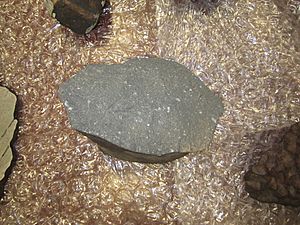Ca-Al-rich inclusions facts for kids

A calcium–aluminium-rich inclusion (CAI) is a tiny, light-colored piece found inside certain meteorites. These special pieces are rich in calcium and aluminium. Scientists believe CAIs are the oldest known materials in our Solar System.
What are CAIs and How Did They Form?
CAIs are made of minerals that were among the very first solids to form in the early Solar System. Imagine a giant cloud of gas and dust that was slowly collapsing to form the Sun and planets. This cloud is called the protoplanetary disk.
The Birth of Solids in Space
CAIs are thought to have formed from very hot gas in this early disk. As the gas cooled down, tiny solid bits started to appear. These tiny bits clumped together to form CAIs. Some CAIs might have melted and reformed later, giving them different shapes and textures.
Dating the Oldest Materials
Scientists use special methods, like radiometric dating, to find out how old these CAIs are. By studying a CAI from a meteorite called NWA 2364, they calculated its age to be about 4568.22 million years old. This incredible age helps us understand when our planetary system first began to form.
CAIs are even older than other common parts of meteorites called chondrules. CAIs formed up to 3 million years before most chondrules appeared. This makes CAIs like ancient time capsules, holding clues about the very beginning of our cosmic home!

